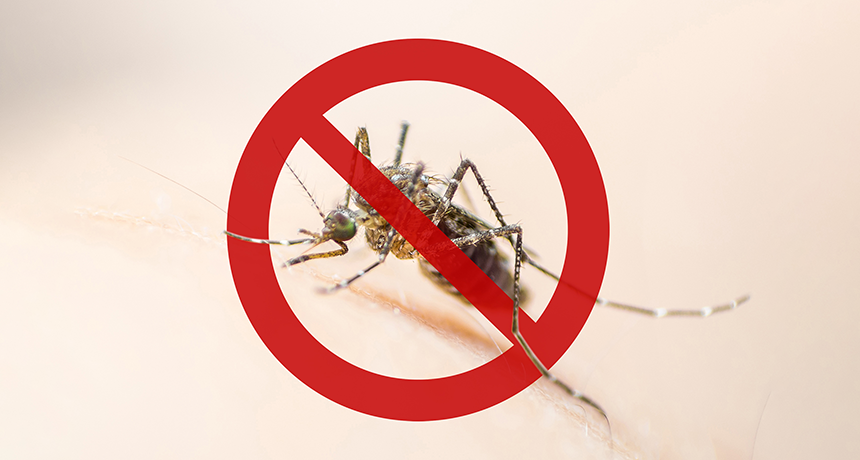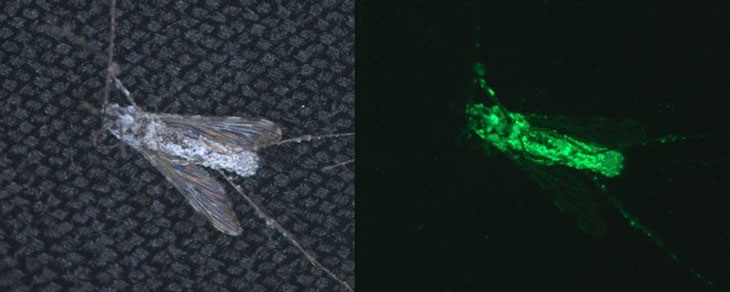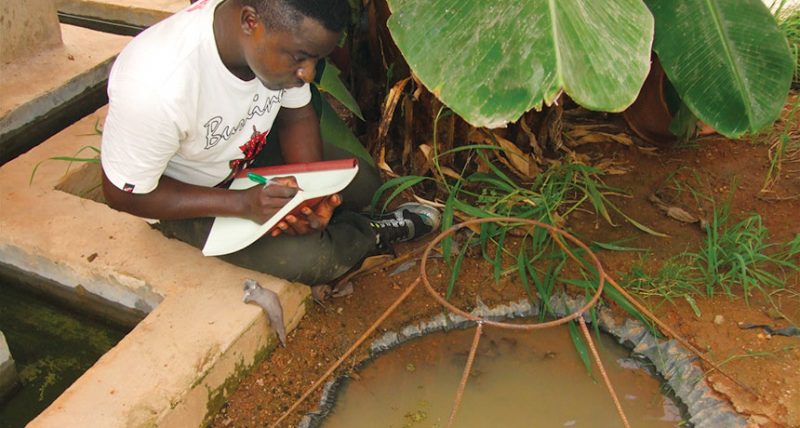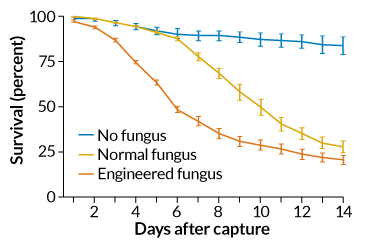A fungus plus a spider toxin equals a weapon to kill mosquitoes
In almost-outdoor experiments, an engineered fungus killed malaria-spreading insects

A new tactic swats at malaria by infecting the disease-carrying mosquitoes with a toxic fungus.
noipornpan/iStock/Getty Images Plus
Share this:
- Share via email (Opens in new window) Email
- Click to share on Facebook (Opens in new window) Facebook
- Click to share on X (Opens in new window) X
- Click to share on Pinterest (Opens in new window) Pinterest
- Click to share on Reddit (Opens in new window) Reddit
- Share to Google Classroom (Opens in new window) Google Classroom
- Click to print (Opens in new window) Print
Malaria currently afflicts more than 200 million people across 87 countries. And the mosquito-borne disease kills about 435,000 of those people each year. Some of the mosquitoes that spread malaria no longer die when exposed to insecticides. That’s prompted scientists to try a new tactic: They’re infecting the insects with a modified fungus — one able to kill them with a spider poison.
The new tests show great promise. The fungus wiped out mosquito populations within two generations. If the result holds up, the modified fungus may one day become a tool for slowing the spread of malaria.
Some 92 in every 100 cases of malaria and 93 in every 100 deaths from the disease occur in Africa, according to the World Health Organization. So scientists decided to set up their new fungal trial in the West African nation of Burkina Faso.
The fungus — Metarhizium pingshaense (Meh-tah-RY-zee-um Ping-SHENZ) — infects and kills mosquitoes. Researchers made it even deadlier to the insects by adding a spider gene. That gene makes a spider-bite toxin called Hybrid. “We’re just bypassing the spider fangs and getting the fungus to do the same job,” says Raymond St. Leger. He’s an entomologist at the University of Maryland in College Park.
He was part of the team that engineered the fungus. It makes Hybrid, but only when it’s in the mosquito version of blood. This substance is called hemolymph.

In laboratory trials in 2011, researchers tested other engineered fungi, ones related to M. pingshaense. Those fungi infected and killed mosquitoes and the malaria-causing parasites that they carried. (These fungi don’t harm people, other insects or animals.) “That’s all well and good, but what happens in the lab doesn’t necessarily translate into field conditions,” notes Brian Lovett, also at Maryland. He’s an insect pathologist and bioengineer who worked on both studies.
The fungi don’t hold up well in heat or under ultraviolet light. So to learn more, researchers needed to test the fungi outdoors. Or, as close to outdoors as possible. But because the engineered M. pingshaense carries a foreign gene, researchers also needed to be cautious. “We can’t just waltz out into the open field and start applying it to people’s houses,” Lovett says.
No more mosquitoes
Lovett’s team worked with scientists and villagers in a western region of Burkina Faso where malaria is common.
First, they built a giant frame. Then they enclosed it with two layers of netting. The team divided the frame into sections with huts on the inside. In each hut, a black cloth hung on one wall. This gave female mosquitoes a place to rest after feeding. The cloths were coated in sesame oil to help fungal spores stick. One hut had a cloth with no spores. Another had normal spores for fungi that don’t make the spider toxin. The third hut’s cloth held spores for Hybrid-making fungi.
Researchers then put 1,000 adult male mosquitoes and 500 females into each hut. The bugs were insecticide-resistant mosquitoes. Local people had collected them as larvae and eggs from puddles.

When the mosquitoes mate, females dive into a swarm of males. Afterward, females must feed on blood to nourish their eggs. For three nights each week, the researchers put calves into the huts. The mosquitoes drank blood from these baby cows. The researchers then counted how many adult mosquitoes survived in following generations.
In the hut without the fungus, 921 mosquitoes hatched in the first generation. About 25 days later, in the second generation, there were 1,396 hatchlings. In the hut with the normal fungus, just 436 mosquitoes in the first generation and 455 in the second. That hinted that the fungus alone could keep numbers down. But it didn’t wipe out the insects.
In the hut with the fungi that made the Hybrid toxin, 399 mosquitoes hatched in the first generation. In the second generation, only 13 adults survived. That’s not enough mosquitoes to form a mating swarm. So the population was essentially wiped out, Lovett explains.
His team repeated the experiment three times during the rainy season from June to October. Each time, they got similar results.
The researchers shared their findings May 31 in Science.
Swifter death
Survival of captured mosquitoes following exposure to a fungus engineered to make a spider toxin

Better than nature?
“The results are exciting, but there’s still a lot of work to be done,” says Adriana Costero-Saint Denis. She’s an entomologist (insect biologist) at the National Institute of Allergy and Infectious Diseases in Rockville, Md. That institute helped fund the research. The researchers still need to work out some details, Costero-Saint Denis says. For example, what’s the best place to hang the cloth? From the ceiling? On the walls? In bedrooms? Or perhaps near doors and windows?
Costero-Saint Denis does think the study’s setting was “better than the lab.” Although the setting was somewhat artificial, she notes, the temperature and humidity were natural.
Researchers will have to see if the engineered fungi work well in future real-world tests. If so, the fungi could be combined with insecticides or other tools to tackle malaria, says Nsa Dada. She’s a medical entomologist with the Centers for Disease Control and Prevention in Atlanta, Ga. A host of different mosquito species can transmit malaria. The new tests used just one. Dada wonders if the fungus would work as well against those other species.
As good as the new study was, it doesn’t prove that the engineered fungus is an improvement over nature, says Matthew Thomas. He’s an ecological entomologist at Pennsylvania State University in State College.
In two weeks, the genetically modified fungus cut the study’s mosquito populations by about three-quarters. But other species of unmodified fungi can kill 100 percent of mosquitoes in five or six days, says Thomas.







